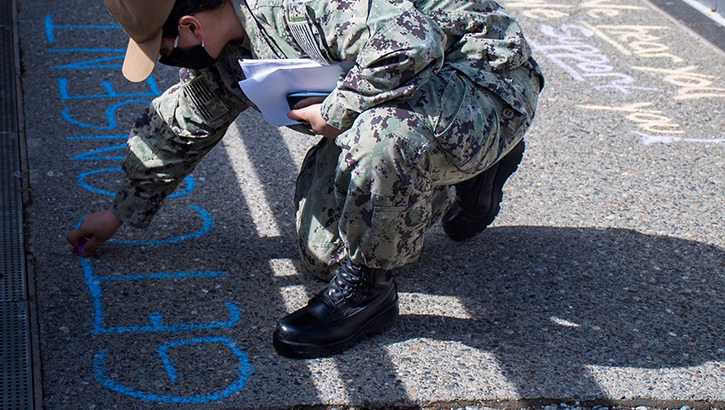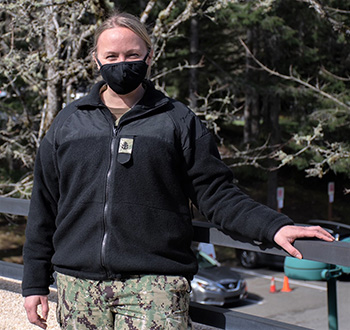A Month of Prevention and Intervention for a Lifetime
 In conjunction with April being Sexual Assault Awareness and Prevention Month, Navy Chief Hospital Corpsman Elizabeth Barraza lends support to Navy Medicine Readiness and Training Command Bremerton’s annual Chalk the Walk event, where staff like Barraza, as well as patients, have an opportunity to write positive and supportive messages regarding SAAPM (Photo by: Navy Hospitalman Madeleine Connaway, NMRTC Bremerton).
In conjunction with April being Sexual Assault Awareness and Prevention Month, Navy Chief Hospital Corpsman Elizabeth Barraza lends support to Navy Medicine Readiness and Training Command Bremerton’s annual Chalk the Walk event, where staff like Barraza, as well as patients, have an opportunity to write positive and supportive messages regarding SAAPM (Photo by: Navy Hospitalman Madeleine Connaway, NMRTC Bremerton).
There were one thousand, six hundred and ninety six 'justifications' Navy-wide in 2019 — 90 in the Pacific Northwest — why Sexual Assault Awareness and Prevention Month (SAAPM) is annually held in April.
That's nearly 1,700 allegations of sexual assaults, sexual trauma, sexual violence reported in the Navy for 2019.
The ongoing Department of Defense theme for SAAPM is "Protecting Our People Protects Our Mission." DOD is observing SAAPM by focusing on creating the appropriate culture to eliminate sexual assault and encouraging a personal commitment from every service member to do their part to create a healthy environment.
As part of the Defense Health Agency, Navy Medicine Readiness and Training Command (NMRTC) Bremerton is actively engaged in eliminating any type of sexual assault - and harassment - with ongoing education, insight and involvement. There is added emphasis on prevention and intervention.
"SAAPM is important to raise awareness about sexual assault and to promote the prevention of sexual violence. The April campaign was created to help spread information and facts about rape and other sex-related crimes. It is important not only in April, but at all times to spread this message and promote a zero tolerance for sexual assault," said Navy Chief Hospital Corpsman Jenny Singer, NMRTC Bremerton Sexual Assault Prevention and Response (SAPR) program coordinator.
The Navy is encouraging it sailors to engage in active intervention to help prevent sexual assault and other destructive behaviors. Prevention efforts are having an effect. The Department of the Navy policy is clear: sexual assault or harassment does not belong in the military.
There are intervention strategies Navy experts recommend that everyone can use to help someone who may be targeted for a sexual assault by a predator.
Direct intervention
Direct intervention involve speaking directly to those involved in the situation. By doing this, you can communicate that a particular behavior is not acceptable nor tolerated at your command, base or community.
Examples
- Ask if everything is alright.
- Address the concerning behavior and state that you think they could possibly cross a line.
- Tell the aggressor to leave the potential target alone or step away from the situation.
Pull aside the potential target, let them know you are concerned, and /or ask if they would like any help getting home safely.
Enlist Others to Help
Enlisting other trusted people can take a variety of forms, in which you diffuse a potentially risky situation by indirect means.
Examples
- Go find the friends of those involved and urge the friends to help remove them from the situation.
- At bars and restaurants, tell a bartender, security staff or manager that you are concerned about a potentially risky situation.
 Navy Chief Hospital Corpsman Jenny Singer, Navy Medicine Readiness Training Command Bremerton Sexual Assault Prevention and Response program coordinator, oversees the command’s involvement in helping to recognize April as Sexual Assault Awareness and Prevention Month. Singer also provides coordination and oversight of compliance with SAPR program requirements, ensuring that command members receive general military training, are aware of SAPR resources, and know who – and how - to get timely assistance if needed (Photo by: Navy Hospitalman Madeleine Connaway, NMRTC Bremerton).
Navy Chief Hospital Corpsman Jenny Singer, Navy Medicine Readiness Training Command Bremerton Sexual Assault Prevention and Response program coordinator, oversees the command’s involvement in helping to recognize April as Sexual Assault Awareness and Prevention Month. Singer also provides coordination and oversight of compliance with SAPR program requirements, ensuring that command members receive general military training, are aware of SAPR resources, and know who – and how - to get timely assistance if needed (Photo by: Navy Hospitalman Madeleine Connaway, NMRTC Bremerton).
Distraction
Distraction is a form of indirect intervention that can help diffuse a potentially risky situation by creating a diversion to interrupt the behavior.
Examples
- Ask the aggressor an unrelated question, such as, ‘How do you get to the commissary? "Do you know when this place closes?"
- This may give the potential target the opportunity to leave the situation. Make up an excuse to help the potential target get away, Such as "I think I lost my phone. Can you help me look for it?"
Protocol
If you are unsure of how to safely intervene, or the situation escalates, seek the help of your chain of command or law enforcement.
Personal safety is very important for all involved, including the person doing the direct intervention. Before deciding to actively intervene in a situation, consider the following:
- Is there a problem or risky situation?
- What resources and options are available if I intervene?
- Who else might be able to assist me in this situation?
- What are the pros and cons of taking action?
Along with direct intervention tactics, ongoing prevention awareness is considered just as imperative. Towards that goal, NMRTC Bremerton has several events planned for this month. There will be a "Chalk the Walk" event, where staff and patients have an opportunity to write positive and supportive messages regarding SAAPM.
"We are also planning a few other events that brings awareness to victim blaming and destructive myths that surround sexual violence. That's important. Sexual assault is not the victim's fault. They didn't encourage someone to assault them," Singer said.
In her position, Singer provides oversight of NMRTC Bremerton compliance with SAPR program requirements, ensuring that command members receive general military training, are aware of SAPR resources, and know who—and how— to get timely assistance if needed, such as with the command SAPR victim advocates.
"The victim advocates are such a crucial part of the program," stated Singer. "They provide the ongoing support to the victim and assist them with navigating processes to get the care and services they need."
SAPR victim advocates provide continuous victim support throughout the incident reporting process, initial and ongoing investigation, as well as any court proceedings. They supply all information to the victim so that he or she can make the best decision and serves as a liaison between the victim and service providers.
Along with local resources like victim advocates, there is the DOD Safe Helpline available around the clock for live one-on-one help and confidential victim assistance: 877-995-5247.
The Military Health System also offers a variety of health and wellness resources to assist any victim, both mentally and physically. Any type of sexual trauma can be physically and emotionally harmful and can lead to self-harming behavior, including suicidal ideation. Anyone experiencing suicidal ideation can:
- Call the Military & Veterans Crisis Line by dialing 988 and selecting Option 1
- Visit the DOD Safe Helpline for more information about reporting options, local resources and crisis intervention.
- Contact the National Sexual Assault Hotline (1-800-656-HOPE), or a local rape crisis center.
"One of the most beneficial tools any person struggling to cope with a traumatic event can receive is support," exclaimed Navy Chief Engineman John Antoine, Substance Abuse Rehabilitation counselor and Mental Health department leading chief petty officer.
According to the DOD Sexual Assault Prevention and Response Office, sexual assault is the nation's most underreported violent crime. In the U.S, a sexual assault occurs approximately every 90 seconds. Sexual assault does not discriminate. It affects men, women, and children of all racial, cultural and socioeconomic backgrounds. There has also been an increase in sexual assault reported in DOD.
"Everyone needs to know about SAAPM! It takes everyone's effort to be able to recognize and stop these behaviors early on to ensure a safe environment of trust and respect for each other," added Singer.